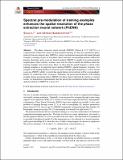Spectral pre-modulation of training examples enhances the spatial resolution of the phase extraction neural network (PhENN)
Author(s)
Li, Shuai; Barbastathis, George
Downloadoe-26-22-29340.pdf (11.51Mb)
PUBLISHER_POLICY
Publisher Policy
Article is made available in accordance with the publisher's policy and may be subject to US copyright law. Please refer to the publisher's site for terms of use.
Terms of use
Metadata
Show full item recordAbstract
The phase extraction neural network (PhENN) [Optica 4, 1117 (2017)] is a computational architecture, based on deep machine learning, for lens-less quantitative phase retrieval from raw intensity data. PhENN is a deep convolutional neural network trained through examples consisting of pairs of true phase objects and their corresponding intensity diffraction patterns; thereafter, given a test raw intensity pattern, PhENN is capable of reconstructing the original phase object robustly, in many cases even for objects outside the database where the training examples were drawn from. Here, we show that the spatial frequency content of the training examples is an important factor limiting PhENN's spatial frequency response. For example, if the training database is relatively sparse in high spatial frequencies, as most natural scenes are, PhENN's ability to resolve fine spatial features in test patterns will be correspondingly limited. To combat this issue, we propose "flattening" the power spectral density of the training examples before presenting them to PhENN. For phase objects following the statistics of natural scenes, we demonstrate experimentally that the spectral pre-modulation method enhances the spatial resolution of PhENN by a factor of 2.
Date issued
2018-10Department
Massachusetts Institute of Technology. Department of Mechanical EngineeringJournal
Optics Express
Publisher
Optical Society of America
Citation
Li, Shuai, and George Barbastathis. “Spectral Pre-Modulation of Training Examples Enhances the Spatial Resolution of the Phase Extraction Neural Network (PhENN).” Optics Express 26, no. 22 (October 25, 2018): 29340.
Version: Final published version
ISSN
1094-4087